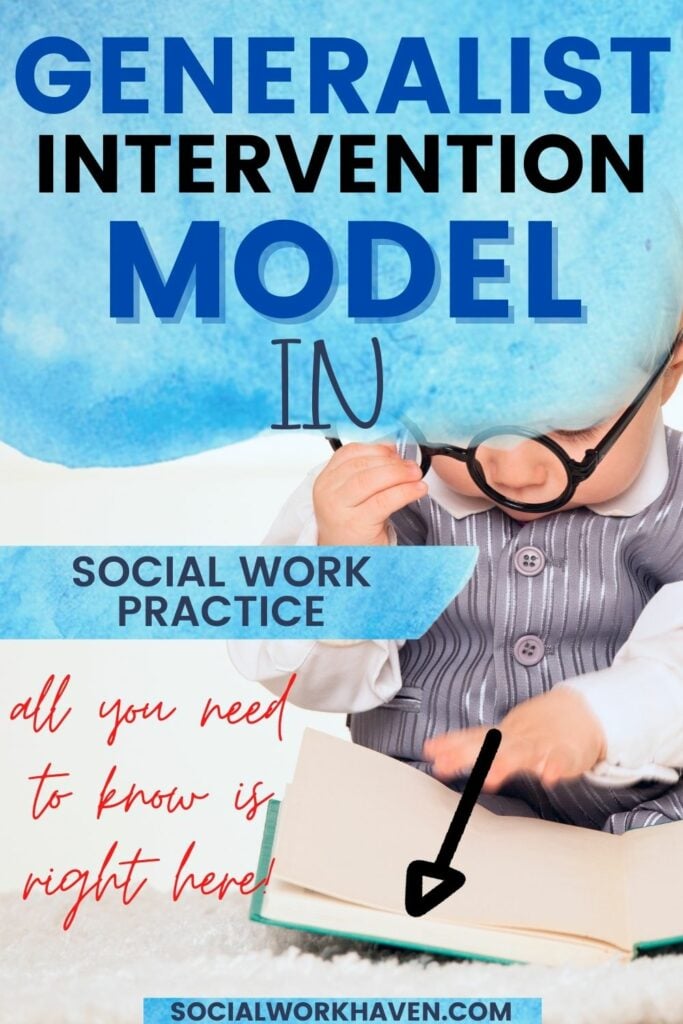

So, how does the generalist intervention model help social workers support service users or clients better?
This article outlines the generalist intervention model which is an important macro-social work theory. This approach provides a holistic and comprehensive social work service to clients, taking into account their individual needs and their environment.
The generalist intervention model requires practitioners to have a good understanding of all aspects of social work practice – from knowledge of different sources of support, to assessing service users’ needs, creating goals and developing action plans.
TRENDING CONTENT ON SOCIALWORKHAVEN.COM
The generalist intervention model follows four premises:
1–Social and physical environment is what makes people behave in a certain way.
2–By changing or modifying anything related to the social or physical environment, human behaviour can be altered.
3–Work with any level of a human system uses similar social work processes.
4–Generalist practitioners have responsibilities beyond direct practice to work towards social policies.
Social work programmes are usually entrenched in the generalist model.
However, once a social work student becomes a newly qualified social worker, there are opportunities to specialise in areas of interest such as becoming a mental health social worker, older persons social worker or a social worker in children’s services.
The generalist intervention model assist social workers in supporting service users or clients effectively.
The process follows 7 stages as follows;

In the engagement stage, the social worker approaches the clients and tries to build a relationship, and within that relationship, they try to build trust.
It is a process that requires active listening and empathy.
It’s the first time the social worker and the client meet; the importance of first impressions here plays a fundamental role.
First impressions are important because they last well beyond that moment; the client will remember that moment until the last interaction they’ll have with the social worker.
Any future interaction will be based – on an unconscious level – on that first impression.
This is called the primacy effect; in short, when someone experiences something before other things happen in a sequence, they remember that first thing more.

In this phase, the social worker will ask questions in order to understand the problems better than the clients’ struggles and find a suitable solution.
If the professional is working with children, they will use an “all about me” assessment; it is a series of questions that the children will have to answer for the social worker to understand better their client.
It usually has some questions about their favorite things to do, their opinion on things like school or family-related, and to make it even more child-friendly, at the end of the assessment, the child can colour it however they like.
Teachers also use it in the school to get to know their students better.
In most local authorities, social workers may complete a Children and Families (CF) Assessment when working in children’s services.
The Children Act 1989 provides the legal basis for social work assessment of a child and his / her family.
Social workers may also complete a needs assessment when working in adult services.
The Care Act 2014 provides the legal basis for social work needs assessment of adults.
Other assessments may include mental capacity assessments which follows the Mental Capacity Act (2005) legal framework.
The assessment stage goes side by side with the engagement because a social worker is engaging and interacting with the child or adult during an assessment.

In the planning stage, the focus is on goal development. The social worker and the clients work together to develop an action plan that includes specific objectives and tasks.
Patience is essential because the client might become frustrated if they can’t reach a specific goal or their expectations aren’t met; the social worker has to reassure them and help them by giving advice or showing them the best way to reach that goal.
Planning and implementation also go side by side; the social worker monitors the client’s progress.
The client has an active role in bringing up challenges, obstacles, or threats that won’t allow them to carry out the action plan.
Therefore, it is important to have a good relationship with the client; and there needs to be mutual trust and understanding.
During the evaluation stage, the social worker keeps track of the progress and monitors the client.
It’s at this stage that the professional has to decide to change the plan if the previous plan isn’t working.
This stage calls for critical evaluation and reflection.
Upon reflection, the social worker might decide to return to the assessment stage to better identify the needs of the client or service user.

The ultimate goal of any intervention is to make sure that the client can maintain changes and monitor any progress independently, without the help of any professional.
There is also a follow-up stage where, after a certain amount of time, the social worker checks on the client to see if the progress is still there or another intervention is necessary.
If the social worker evaluates the situation correctly, they can potentially make someone’s life better.
That’s how rewarding this profession can be.
For social workers, the generalist intervention model offers a guide to supporting clients or service users on their path to self actualisation and self-determination.
It can help inform specific interventions and approaches in practice.
The process follows 7 stages as follows;
READ NEXT
PIN IT FOR LATER!

Social Work To – Do List: What To Include: We sometimes struggle with managing our daily tasks as social workers. This is not because we do not have the skills. The work load, crisis and challenges we face can be overwhelming. That is why a social work to-do list may help us manage better.
Best Social Work Books Every Student Must Read is a great article full of highly recommended and engaging books. Helping student social workers to equip themselves with knowledge and skills. It is a great way to empower yourself and encourage you to read more.
Social Work Registration: Get it done – is a useful article that walks you through the social work registration process.
51 Effective Ways to Fight Social Work Burnout helps practitioners explore 51 effective ways to fight Social Work Burnout. Social work burnout can affect the way we execute our role. It can cause social work stress, and a stressed social worker cannot perform their role effectively.
Why You Should Actively Listen as a Social Worker raises awareness of active listening in social work. Social work active listening involves the listener paying close attention to the speaker, making sure not to interrupt, and reflecting on what they have heard. This helps the speaker feel heard and validated, and it can also help them clarify their thoughts and feelings.
Social Work Humour for the End of a Long Day This article explains when social work humour is important. Essential social work skills include empathy, authenticity, resilience and respect. These skills help us cope with situations and meet the needs of service users or clients. However, the best coping mechanism in social work is definitely humour.